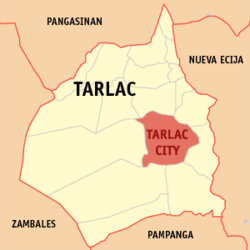
History
From Bacolor, Pampanga came the leaders and first settlers who cleared the land, fertile the soil, and started a settlement in the area now known as Tarlac City. It was formally founded in 1788. The little community grew rapidly as settlers from Zambales, Pampanga, Bataan and elsewhere flocked the town. The Pampanga dialect became the native language of the town as it was part of Pampanga province in those days. Decades after, roads were built and barrios were established without monetary expenditure but only through the common efforts of everyone.
It is said, “the past is a prologue to the future”. This brief account of the town’s colorful history is by no means complete. Since 1788, the town has progressed significantly, leading to its becoming the nucleus of Tarlac province. It has encountered countless hardships in the course of its existence, including those precipitated by earthquakes, cholera and other epidemics, great fires, devastating floods and similar calamities. Through the years, Tarlac’s ability to survive wars, economic difficulties and political turmoil among others, has been proven by its consistent re-emergence as a stronger and better town, eager to meet the challenges of tomorrow.
 Then, on April 18, 1998, through a plebiscite the citizenry overwhelmingly supported the conversion of Tarlac town into a component city with affirmative votes of 21,378 out of 26,020 votes. It was proclaimed as a component city on April 19, 1998 by virtue of Republic Act No. 8593 to be known as the City of Tarlac.
Then, on April 18, 1998, through a plebiscite the citizenry overwhelmingly supported the conversion of Tarlac town into a component city with affirmative votes of 21,378 out of 26,020 votes. It was proclaimed as a component city on April 19, 1998 by virtue of Republic Act No. 8593 to be known as the City of Tarlac.
Population/ Language/ Area
 The 318,332 population (2010 census) of Tarlac City is consists of 73% are Christians. The majority of these Christians are members of Iglesia Ni Cristo and Roman Catholic with minorities of Protestants. The remaining 27% is non Christian such as Muslims and others.
The 318,332 population (2010 census) of Tarlac City is consists of 73% are Christians. The majority of these Christians are members of Iglesia Ni Cristo and Roman Catholic with minorities of Protestants. The remaining 27% is non Christian such as Muslims and others.
Tarlac City, with a total land area of 274.66 km2 (106.05 sq mi), is located 125 kilometers north of Manila. It is bounded on the north by the municipality of Gerona, on the east by the towns of Victoria and La Paz, on the south by the towns of Conception and Capas, and on the west by San Jose town. The city is accessible through the McArthur Highway (National Highway) and now connected with Clark and Subic Freeport through the new SCT Expressway. Terrain is defined by lowland where the city center is located and which form part of the great central plain of Luzon Island. On the western part, however, are found hills and mountains. Tarlac River traverse the western part of the city center.
Products and Services
Agriculture is the main source of income for the city. Sugar, rice, root crops, vegetables, livestock and poultry are the chief farm products of the city. Large manufacturing enterprises are concentrated at the Luisita Industrial Park where rubber tires, electronics, and automotive wiring sets are produced. Due to the rapid urbanization, several residential subdivisions mushroomed along the sides of the National Highway.
Business Opportunity
 Being a fast rising economic powerhouse in the region, the city offers several advantages to business locators. It is adjacent to several other large urban centers of Central Luzon and is traversed by the National Highway and is the endpoint of the new Subic-Clark-Tarlac Expressway (SCTEx). Investors can put up real estate projects such as housing and commercial complexes, tourist-related ventures such as hotels, resorts, entertainment facilities and demonstration farms, and technology companies like call centers. In manufacturing, the city is an ideal place to establish agribusiness-related factories for food processing, farm machinery, feeds, and fertilizer. Export-oriented plants are also encouraged.
Being a fast rising economic powerhouse in the region, the city offers several advantages to business locators. It is adjacent to several other large urban centers of Central Luzon and is traversed by the National Highway and is the endpoint of the new Subic-Clark-Tarlac Expressway (SCTEx). Investors can put up real estate projects such as housing and commercial complexes, tourist-related ventures such as hotels, resorts, entertainment facilities and demonstration farms, and technology companies like call centers. In manufacturing, the city is an ideal place to establish agribusiness-related factories for food processing, farm machinery, feeds, and fertilizer. Export-oriented plants are also encouraged.
Tourist Spots
- Tarlac Museum – this museum has an extensive collection of official documents of the different revolutionary personalities like the letters of Francisco Makabulos and Gen. Servillano Aquino.
- Monasteryo de Tarlac – located at the Tarlac Eco- Tourism Park, Brgy. Lubigan, San Jose, Tarlac.
Festivals and Celebrations
The Malatarlak Festival, celebrated every January, is the most common festival in the city. In 2011, Mayor Ace Manalang changed the name of the festival to Melting pot Festival. Although it is still remembered by its former name.

